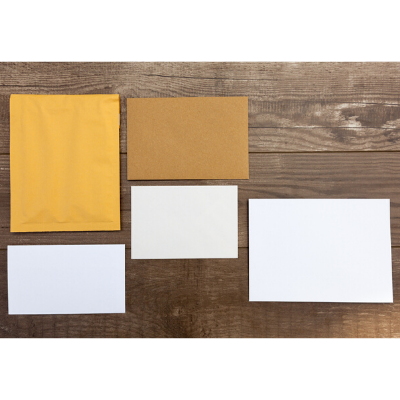The #10 envelope is a popular choice for mailers. You can easily find resources on the size of a #10 envelope and even some on how to measure it. But why is this envelope called a #10, and where did other commonly used envelopes get their names?
Let’s take a lesson on the history of envelope size names.
The Dawn of Machine-Folded Envelopes
The first envelope folding machine was invented during the 1850s, creating a surge in the amount of mail being sent as envelopes were being produced at a much faster rate. Demand for machine-made envelopes continued to grow so much over the next few decades that a classification system for various sizes and shapes of available envelopes became necessary.
Stationers’ Handbook of 1876
An envelope manufacturer named William Irwin Martin created a system to identify envelopes by size for a publication called the Stationers’ Handbook of 1876. Prior to Martin’s system, envelope sizes were determined by envelope manufacturers. This created inconsistencies across envelope sizes.
Standard Envelope Size Names
Martin identified names based on die sizes that were available in the 1870s. He designated names for 10 business-sized envelopes ranging from the smallest to largest size available:
| Envelope Name | Size in Inches |
|---|---|
| 6 1/4 | 3 1/2 x 6 |
| 6 1/2 | 3 1/2 x 6 1/4 |
| 6 3/4 | 3 5/8 x 6 1/2 |
| #7 | 3 3/4 x 6 3/4 |
| #7 3/4 | 3 7/8 x 7 1/2 |
| #9 | 3 7/8 x 8 7/8 |
| #10 | 4 1/8 x 9 1/2 |
| #11 | 4 1/2 x 10 3/8 |
| #12 | 4 3/4 x 11 |
| #14 | 5 x 11 1/2 |
Then vs. Now
Modern envelope manufacturers continue to reference the names designated by Martin when describing common envelope sizes. While we understand that our customers may have a need for common envelope sizes as referenced by Martin’s system, Tension produces custom envelopes based on your specific requirements. To us, there is no “common” envelope size yet we recognize the names used to refer to envelope sizes.
Contact Tension
When it comes to making a marketing impact, we think the envelope is a perfect 10 no matter its size or name. It’s tactile, making it a unique form of communication in a sea of digital alternatives, and elicits a strong 9% response rate. Contact a Tension expert to get started on your marketing impact today.




